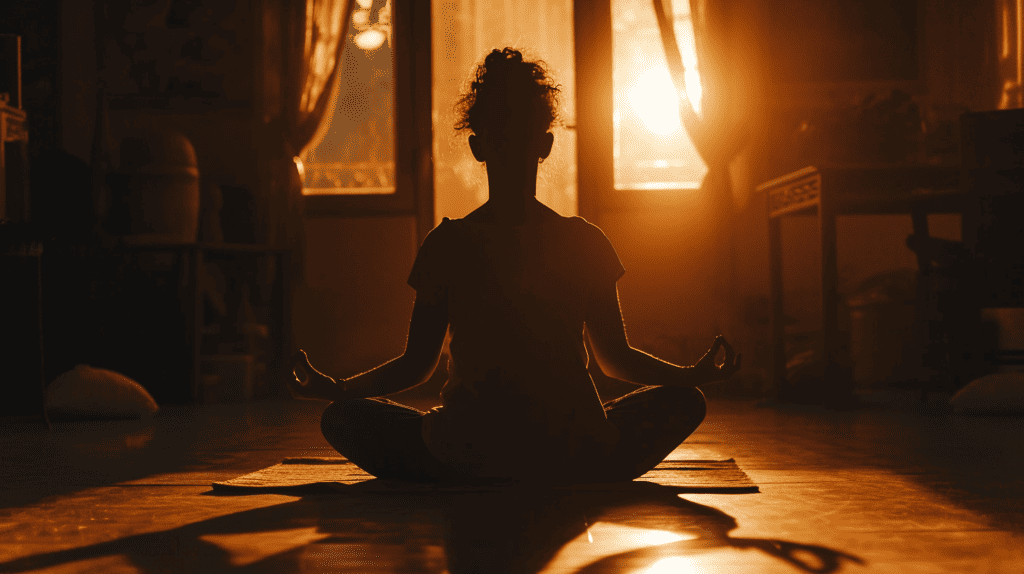Guided meditation refers to a meditation session where guidance is provided, often via an audio recording, to help lead the meditator. In Alcoholics Anonymous (AA), guided meditations tend to draw from and reflect the 12 Step principles and focus on themes like surrender, wisdom, freedom from addiction, spirituality, and connecting to a higher power. As always, consult with your AA group before starting the 11th step.
Key Takeaways
Guided meditation serves AA members by:
- Reducing cravings and supporting sobriety
- Managing difficult emotions more skillfully
- Deepening spiritual connections
- Enhancing clarity and emotional health
Common types of guided meditations used in AA
This is one of the best videos to follow along with while doing your meditation. The video above focuses on the 11th Step Morning Meditation, and here are some key points you will get from this video:
- Morning meditation is suggested, even alone if necessary.
- The focus of morning meditation is to seek guidance for the day ahead.
- Prayer is used to ask for divine direction, the removal of selfish motives, and the ability to face life’s challenges with serenity.
- Trust in God’s guidance and reliance on Him are essential.
- A willingness to make amends and seek God’s will is emphasized.
- The importance of humility, patience, tolerance, kindness, and love is highlighted.
- The spiritual life is not just a theory but something to be lived.
- Continuous self-reflection, surrender to God’s will, and making amends are key components.
- The importance of helping others and being in spiritual fellowship is stressed.
- The prayer for the removal of character defects and strength to carry out God’s will is significant.
Alcoholics Anonymous suggests: Set aside a specific time each day to meditate, focusing on your higher power and recovery, or on other daily issues if necessary, to prevent overlapping of different concerns.
Here are some other meditations essential to AA that help with the healing process:
Breathing Meditations – These simple meditations involve following guidance to deeply relax by focusing on one’s breath. They help calm the mind.
I often start my day with a 10-minute breathing meditation from Mind Valley to feel centered and relieve anxiety.
Body Scans – These slowly and systematically guide one to notice sensation in different parts of the body. They promote mindfulness.
Visualization Meditations – These involve envisioning scenarios, symbols, metaphors, or journeys that represent personal growth tools related to recovery.
Affirmation Meditations – These use repeated positive mantras and statements to reprogram thinking patterns.
Gratitude Meditations – These use prompts to reflect on and cultivate gratitude related to sobriety.
Higher Power Meditations – These encourage feeling connected to and inspired by a spiritual presence.
12 Step Meditations – These directly use AA principles and steps as a framework.
What is the Purpose of Meditation for AA

Guided meditation serves many purposes for AA members, including:
- Strengthen sobriety – Meditation enhances clarity and resilience to stay substance-free.
- Reduce stress – Meditation counters anxiety, frustration, fatigue, and cravings.
- Promote serenity – Meditation cultivates equanimity, peace, and positivity.
- Deepen spirituality – Meditation helps connect to truth beyond surface perceptions.
- Improve concentration – Meditation trains ability to focus thinking.
- Facilitate self-awareness – Meditation reveals insights about addictive patterns.
- Aid emotional health – Meditation balances and uplifts mood and outlook.
I mainly use meditation to handle life’s daily ups and downs with more grace and inner stillness.
Typical Session Length
Guided meditation sessions in AA typically range from 5 to 20 minutes long. Short 5-10 minute meditations are very common, as they easily fit into a routine. Meditations up to or over 20 minutes tend to be less common, reserved for occasions when one wants a longer, deeper experience. Different lengths serve different functions.
For example, a quick 5 minute meditation could provide a calming centering break, while a 20 minute session may allow more time to work through challenging emotions or explore self-reflections. Individual needs and time constraints determine what length works best.
I find starting with just 5-10 minutes very accessible. Over time, I’ve worked up to occasionally doing 20-30 minute meditations.
Frequency of Practice
AA members who utilize guided meditation tend to practice ranging from 1 to 7 times per week, most commonly once a day or every few days. Recommended frequency depends on individual factors.
In early sobriety, more time may be needed for centering and coping. Later on, less frequent meditation may suit a stable routine. Some find benefit from meditating in moments of sudden need for grounding. Also, the length of each session impacts overall time investment.
I aim to meditate daily – but don’t beat myself up over missing days. Making it to 3-4 times a week works fine.
Benefits for AA Members
Guided meditation offers AA members many potential benefits, including:
Physical Benefits:
- Reduced blood pressure, heart rate
- Less muscle tension
- Improved sleep
Mental & Emotional Benefits:
- Decreased anxiety, sadness, anger
- Enhanced concentration, learning
- More positive outlook and feelings
Spiritual Benefits:
- Greater sense of meaning and purpose
- Feelings of transcendence
- Ability to trascend the ego
Recovery Benefits:
- Lower incidence of relapse
- Fewer cravings
- Healthier coping strategies
Meditation benefits manifest in interconnected ways – treating mind, body and spirit together to support sobriety.
The clarity meditation gives me hugely aids my recovery by enhancing self-control and centeredness.
Common Focus & Themes
Guided meditations in AA typically focus on:
Inner reflection – Exploring thoughts, beliefs, patterns
Prayer – Seeking inspiration, guidance, grace
Mindfulness – Present moment attention and insight
These themes align with core ideas emphasized in AA about taking personal inventory, seeking spiritual connection through a higher power, and cultivating awareness and acceptance.
For me, guided meditations help strike the right balance – not too much rehashing the past or zoning out, but tuned into the here and now.
Popular Audio Resources
Some audio recordings commonly used for guided meditation in AA include:
Recordings in Literature
- 11th Step guided meditation audio in AA’s Living Sober book
- Appendix II prayer meditation in the Big Book
Third Party Podcasts/Apps
- Recovery Dharma meditation podcasts
- Refuge Recovery meditations
- Insight Timer app (secular and Buddhist-based recordings)
Member-Created Recordings
- Local member recordings from specific groups/areas
- Sponsor-led meditations for sponsees
Accessible resources allow AA members to integrate guided practices easily. Apps and podcasts offer free mediation. Custom resources also help tailor support.
Having a few “go-to” meditation recordings on my phone makes it so easy to squeeze in sessions.
AA Literature Guidance

While no single official “how to” meditation guide exists in AA literature, core texts offer guidance:
Living Sober Book – Details p. 86-88 provide a framework for 11th Step meditation based on the Big Book
12&12 Book – Step 11 chapter gives suggestions for practice
Big Book – Appendix II has a sample prayer meditation
These passages advise on themes to contemplate, attitudes to cultivate, and practices like prayer or quieting the mind. They form a foundation adaptable to individual needs and guided sessions.
Using literature passages as a base meditation “syllabus” helped me better grasp meditation’s role in AA.
Sponsor Led Meditations
Sponsors may sometimes lead sponsees individually or as a group in guided meditation, often by:
- Reading aloud relevant AA literature passages
- Playing and discussing audio recordings
- Sharing personal meditation wisdom
- Leading live impromptu meditations
Sponsor-led meditations allow custom support and creative freedom to interpret concepts. They also build trust and community. This guidance is invaluable yet informal.
My sponsor gifted me recordings she found helpful – listening together strengthened our bond.
| Common AA Meditation Types | Key Characteristics |
|---|---|
| Breathing Meditations | Simple focus on breath |
| Body Scans | Notice physical sensation |
| Visualizations | Imagine scenarios and symbols |
| Affirmations | Repeat positive phrases |
| Gratitude Meditation | Cultivate thankful mindset |
| Higher Power Meditation | Feel spiritual presence |
| 12 Step Meditations | Use AA principles to guide |
TIP: Explore a variety of guided meditation styles to find what resonates. Combine centeredness from breathwork with spiritual insights from higher power visualizations for rounded benefits.
How Most Guided Meditations Begin
Many guided meditation audio recordings used in AA tend to be 10-20 minutes long and follow a similar basic structure:
- Opening reminder of purpose and ground rules
- Brief centering stage
- Main practice guidance
- Closing notes
Introductions set expectations on what the practices aims to accomplish. They also often suggest tips like assuming a comfortable seated posture with eyes closed and back supported.
Centering portions lead initial focusing on the breath, body sensations or emotional state to help settle into an open, nonjudging awareness.
Core practice segments vary based on meditation style, guiding the specific visualizations, affirmations, body scans, etc. This is the main active meditation.
Final portions transition out of the inner experience, perhaps offering perspective or encouragement to carry positive states into the rest of one’s activities.
AA meditations tend to have enough similarities for familiarity, but diversity in guidance focus to enrich members’ inner journeys.
I appreciate beginning sessions by just simply arriving and taking stock before moving onto the unique aspects.
Inspiration Sources for Guided Content
Guided meditation audio selections commonly used in AA draw from a blend of sources for the instructions and themes explored. This variety helps spark new angles of inner wisdom.
Some typical sources of inspiration woven into AA meditation guidance include:
12 Step Principles – Higher power, surrender, inventory, amends
Common Prayers – Serenity Prayer, Lord’s Prayer
Literature Excerpts – Passages from Big Book, 12&12 etc. that offer perspective
Nature Imagery – Lakes, mountains, forests, beaches offer calming backdrops
Recovery Community Stories – Shared struggles and turns illustrate concepts
Spiritual Ideas – Faith, grace, oneness, transcendence
Mindfulness Teachings – Being present, nonjudgmental observation
Diverse influences make AA recordings unique – members can connect most to whatever speaks their language.
Listening to different AA speakers and sponsees within guided meditations makes the journey feel so personal.
11th Step Meditation in Living Sober
The guided meditation audio contained in AA’s Living Sober book stands out as a classic example of format and content. While only 5 minutes long, it manages to work through essential points, including:
Centering Down: Settling body, emotions and thoughts to arrive fully into the present, through non-judging attention primarily to breath
Connecting: Feeling part of humanity, the world and a higher meaning
Accepting: Letting go of past and future preoccupation into calm presence
Visualizing: Imagining moving into a healing light that dissolves ego and suffering
Emerging: Transitioning back renewed, inspired and committed to alignment
This recording begins with a reading of relevant passage pages 86-88 from the book, outlining the meditation theory. Then it moves through distinct stages of practice, concluding by referring back to the reading as a guide to living principles.
I revisit this Living Sober recording since it conveniently summarizes core concepts and serves as an express tune-up.
TYPICAL Elements Woven Through AA Meditations
Common threads tend to run through many guided meditation sessions used in the AA program. Recurring elements scattered throughout provide familiarity and amplify key teachings.
Some typical examples include:
Frequent repetition of mantras like: “One day at a time” and the Serenity Prayer
References to core AA texts like the: “Big Book” and “12 and 12”
Moments of silent pauses for personal reflection
Instances of calming natural background audio like birds or rain
Recovery-themed transitions between sections, such as imagining moving down a path
These unifying features work subconsciously, keeping core AA philosophy activated and lessons integrated mentally through the practices.
Hearing “one day a time” and “Serenity” arise spontaneously guides me to use those principles off the cushion too.
Common practices include breathing meditations, visualizations, etc based on AA concepts. Supportive recordings and literature provide guidance.
Through routine guided meditation, clarity and resilience grow to navigate life’s joys and challenges clean, calm, and wise.
FAQ on AA Guided Meditation
Are Popular Public Domain Guided Meditations Used?
Free online resources for guided meditations outside of AA-created content additionally offer useful support around sobriety and related wellbeing topics. As these are accessible to anyone, AA members commonly use recordings from:
UCLA Mindful Awareness Research Center – recordings on mindfulness, coping
Insight Timer app – 20,000+ recordings on all meditation themes
Calm app – mental health, nature-themed meditations
YouTube channels like TheHonestGuys and many more
Public libraries – CDs like Jon Kabat Zinn’s Mindfulness for Beginners
Supplemental options like these help diversify members’ meditation content libraries erring on secular sides of spiritual concepts.
When I need a straight-forward anxiety or body relaxation session, public meditations really do the trick.
Does Literature Offer How-To Guided Meditation Instructions?
The AA literature presents minimal direct technical guidance on the precise methods and mechanics involved for leading guided meditation sessions. Directions mainly reference developing meditative states of mind rather than outlining procedural steps.
However, the “Big Book” and 12&12 deem three psychic change attitudes (willingness, honesty, open-mindedness) as formational to effective 11th Step work. These crisis prep principles translate into helpful ground rules for readying meditation:
- Willingness – bringing discipline, patience and commitment
- Honesty – having courage and integrity to see oneself clearly
- Open-mindedness – releasing prejudice to expand perspectives
Likewise, the writings frequently touch on useful pointers around assuming a quiet posture and timing practices for optimal alertness. Such peripheral suggestions offer limited yet valuable amateur guidance on getting started. Members then refine methods through experimentation to discover what works uniquely.
Through trial and error, I pieced together my own essentials – like meditating after walks when energy levels sync just right.
Comparing Meditation Across Recovery Programs
AA guided meditation practices contain much similarity to those in aligned 12 Step recovery programs like NA and OA yet also present a few subtle distinctions:
Common Ground of Other Programs:
- Shared principles around powerlessness, higher power
- Addressing underlying causes not just symptoms
- Daily maintenance to sustain growth
- Central goal of conscious contact with higher power
Where AA Meditation Differs:
- More frequent references to core texts (Big Book, etc)
- Heavier emphasis on formal prayer
- Greater focus on alcoholism specifics like cravings or binges
- More directive visualizations like bright lights
So while AA meditation content echoes other programs’, it uniquely spotlights alcohol addiction challenges through its trademark voice and imagery. However, mutual wisdom around spirituality and human behavior change remains transferable.
When I attended an NA retreat, I easily resonated with their guided meditations thanks to the common foundations.
Do Sponsors Lead Meditations for Multiple Sponsees Together?
AA sponsors may sometimes lead a guided meditation not just for an individual sponsee but for a group of multiple sponsees together. Reasons this can be impactful include:
- Creates bonds between members early in sobriety
- Allows new members to learn from veterans
- Provides sponsorship efficiency
- Deepens understanding through shared discussion
- Models vulnerability and community
Often such group sponsor sessions explore foundational recordings or literature passages to establish baselines. These foundations then may be built upon one-on-one through more tailored practices.
When my sponsor invited other sponsees to join meditation, hearing their perspectives motivated me.
How Do Prison/Rehab Guided Meditations Differ?
Specialized AA meetings in controlled environments like prisons and rehabilitation centers may utilize unique tailored guided meditation content to help address members’ circumstances. For example:
Prison Meditations – Emphasize coping strategies for confinement, regulating emotions around extreme environments and transcending traumatic histories. They tap patience, grace and perseverance.
Rehab Meditations – Stress present-moment mindfulness to avoid fixation on difficult pasts or uncertain futures. They encourage embracing support systems. They teach healthy self-parenting skills.
Both settings may incorporate movement like walking or yoga for confined, stressed individuals struggling with focusing solely still. Creative liberty nurtures breakthroughs.
During my center stay, musical meditations helped channel feelings into cathartic expression.
Can Locations Impact Meditation Experience?
Beyond prisons and rehabs, the overall setting for guided meditation can shape experience. Many AA groups hold special meditation workshops or retreats in serene spaces conducive to deepening practices. Popular hosts include:
Outdoor nature settings – forests, gardens, beaches, parks
Spiritual sites – churches, ashrams, monasteries
Wellness/retreat centers – yoga studios, spas, camps
Features like peaceful surroundings, memorable views, powerful architecture and inherent spiritual history allow members to tangibly feel more connected to meditation’s transcendent aspects. Bliss arises effortlessly.
Additionally, removing everyday responsibilities and distractions through stays immersed solely in practice liberates profound states of being.
Attending seaside sunrise meditation on an AA retreat fulfilled me unlike any regular studio session.
Can Meditation Replace Other 12 Step Work?
Guided meditation offers impactful support for recovery and growth, but is not sufficient as a stand-alone solution for the multifaceted AA path of action toward change. Meditation itself serves specifically as Step 11 work while the preceding first 10 steps provide critical foundation.
These earlier parts of the 12 steps ready one for meditation’s full gifts to emerge by establishing: self-honesty (Steps 1-3), self-inventory (Step 4-5), and relationship repairs plus character development (Steps 6-10). Initial inner and outer work allows deeper meditation integration.
Likewise, for sustained thriving, meditation should inspire practical application through Step 12’s selfless service. In summary, guided practices complement – not replace – the full 12 step system.
I need to actually admit my faults and make amends before I can meditate freely without guilt weighing me down internally.
Final Thoughts on the Big Book and Alcoholics Anonymous
In closing, AA guided meditation offers dedicated members a wellspring for virtually all life domains through enhanced mind-body harmony, emotional intelligence and conscious contact with empowering forces within and beyond the finite self.
Dedication through continual practice allows incremental rewiring toward freedom from affliction, as meditation can serve as:
- A preventative to halt addiction and toxicity origination
- An intervention to disrupt downward spiral momentum
- A treatment to heal root causes holistically
- A relapse cure to regain control if needed
- A lifestyle to perpetually thrive joyfully and at peace
Guided meditation provides a container for members to realign with truth, become their best selves, and be of maximum service to others. While requiring commitment through ups and downs, meditation directions ultimately guide one home.
Making meditation a cornerstone aids me to stay happy, useful and free regardless of whatever else may happen on the journey of life. The instructions I once needed from others now arise within to light my path bright.
TIP: Remember determination and patience! Even small amounts of guided meditation can slowly work magic.





Leave a Reply